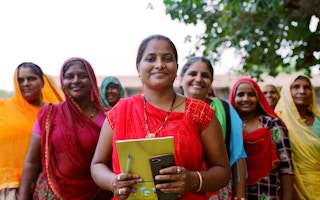This month, the G20, which represents the largest economies in the world, hosted its third meeting of the Global Partnership for Financial Inclusion, a working group dedicated to supporting women’s digital & financial inclusion. We’re glad to see this year’s conference make these issues a priority, even releasing a pair of videos with the hashtag #EmbraceEquity.
The pandemic supercharged fintech innovation, providing new opportunities for women in many countries. But as the sector races ahead, rapid growth could outstrip smart regulation and thoughtful implementation. If the G20 wants to get serious on its promises, it needs to work closely with the financial industry to ensure that ongoing development in the fintech sector is inclusive of and responsive to women and avoids repeating past mistakes. Otherwise, we risk these hashtags becoming empty slogans.
First, let’s understand why financial inclusion is an important part of improving women’s lives. At its most basic, financial inclusion means women can make payments and send money securely and affordably, have an easy and safe way to save money, and have access to basic credit and insurance. Without access to these fundamental financial services, it is difficult for women to pay for a child’s education, build a business, buy a home, or do many things that most of us take for granted.
In our work in developing nations around the globe, Women’s World Banking and Visa Foundation have found that innovations in digital financial services technology have great potential to help underserved women get access to credit and banking services. Our work in Cambodia provides a powerful example.
Between two and three-million low-income young Cambodians do not have traditional banking accounts, but are tech-savvy and have mobile phones. Building off a model piloted in Bangladesh, we worked with a private banking partner who was offering a new mobile-wallet app for garment factory workers, over 90 per cent of whom are women.
“
Access to fintech products starts with access to mobile phones. Women in low- and middle-income countries are 17 per cent less likely to own a mobile phone than men.
At first, many of these women were cashing out their payments as soon as they arrived. But through a series of hands-on trainings, these workers built confidence in using the full range of services available through the app. By December 2022, the program was in place at 60 factories, reaching more than 84,000 women. Forty per cent of these women became active users of their digital accounts and began using the full range of financial services available to them, including savings accounts and short-term loans. In short, they were able to participate in the financial system for the first time.
But unfortunately, not all scenarios are like this example. We’ve seen before how new technologies and financial products can grow too fast for their own good and become tools for reinforcing old biases and inequalities. Here’s a few things G20 and its constituent governments need to do to ensure that fintech expansion serves women:
Enable national digital identification. For women to access the full breadth of the digital economy, it starts with identification. Periodic assessment to ensure women have a digital ID must be in place.
Access to technology. Access to fintech products starts with access to mobile phones. Women in low- and middle-income countries are 17 per cent less likely to own a mobile phone than men. Public policies can be instrumental in closing this gender gap. International pressure may help reduce some barriers to women, such as the requirement to present government ID when buying a phone.
Separate out data by gender. You cannot manage what you can’t measure. To establish targets for improving women’s financial inclusion, we need gender-disaggregated data. This data from financial service providers can provide insights into which policies, companies and markets are driving progress or lagging behind. Regulators can push for the reporting of this data, as well as data on the gender diversity of staff at financial institutions.
Support digital government payments that are accessible to women. Government programs often represent a crucial part of women’s incomes. The G20 should support the development of mechanisms that enable government payments to women to be directly deposited into digital accounts. This allows women to use these funds for a range of digital financial transactions, such as savings and credit.
Encourage gender diverse teams. Gender diverse leadership teams have a key role to play in advancing women’s financial inclusion, by better serving the needs of women customers and developing policies that help close the gender gap. Research from Findexable found that women make up just 11 per cent of all board members on fintechs and just 19 per cent of company executives. It’s essential we build capacity among women in the leadership pipeline and establish peer networks for policymakers around gender inclusive policies and workplaces.
The G20 should work alongside financial companies to keep women’s needs and voices at the centre of the fintech revolution. These new technologies have enormous potential — let’s be sure they don’t go to waste.
This story was published with permission from Thomson Reuters Foundation, the charitable arm of Thomson Reuters, that covers humanitarian news, climate change, resilience, women’s rights, trafficking and property rights. Visit https://www.context.news/.












